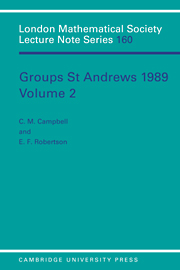Book contents
- Frontmatter
- Contents
- Preface
- Introduction
- 17 A survey of recent results on projective representations of the symmetric groups
- 18 Some applications of graded diagrams in combinatorial group theory
- 19 Rational growth of wreath products
- 20 The modular group and generalized Farey graphs
- 21 On the n-centre of a group
- 22 Existentially closed finitary linear groups
- 23 Permutability and subnormality of subgroups
- 24 Some applications of powerful p-groups
- 25 Combinatorial aspects of finitely generated virtually free groups
- 26 Problems in loop theory for group theorists
- 27 Sylow theory of CC-groups: a survey
- 28 On the minimal number of generators of certain groups
- 29 Lie properties of modular group algebras
- 30 Observations on a conjecture of Hans Zassenhaus
- 31 The Fibonacci groups revisited
- 32 Galois groups
- 33 Infinite simple permutation groups - a survey
- 34 Polynomial 2-cocyles
25 - Combinatorial aspects of finitely generated virtually free groups
Published online by Cambridge University Press: 13 March 2010
- Frontmatter
- Contents
- Preface
- Introduction
- 17 A survey of recent results on projective representations of the symmetric groups
- 18 Some applications of graded diagrams in combinatorial group theory
- 19 Rational growth of wreath products
- 20 The modular group and generalized Farey graphs
- 21 On the n-centre of a group
- 22 Existentially closed finitary linear groups
- 23 Permutability and subnormality of subgroups
- 24 Some applications of powerful p-groups
- 25 Combinatorial aspects of finitely generated virtually free groups
- 26 Problems in loop theory for group theorists
- 27 Sylow theory of CC-groups: a survey
- 28 On the minimal number of generators of certain groups
- 29 Lie properties of modular group algebras
- 30 Observations on a conjecture of Hans Zassenhaus
- 31 The Fibonacci groups revisited
- 32 Galois groups
- 33 Infinite simple permutation groups - a survey
- 34 Polynomial 2-cocyles
Summary
Introduction
Let G be a finitely generated (infinite) virtually free group and denote by mo the least common multiple of the orders of the finite subgroups in G. The purpose of this note is to survey some recently obtained results centring around the arithmetic function be : N → N,
bG(λ)= number of free subgroups of index λmG in G, which indicate a quite intimate relationship between combinatorial and structural properties of G. Proofs and more details will be given elsewhere. Our main results include an asymptotic formula for bG(λ) in terms of a presentation of G as a fundamental group of a finite graph of finite groups in the sense of Bass and Serre and an explicit estimate on the growth behaviour of the difference function bG(λ+1) − bG(λ). Furthermore we consider the question as to what kind of information on the structure of G is contained in the number of free subgroups of finite index and as to what extent this combinatorial information determines the group G.
I would like to thank Robert Bieri and Heinrich Niederhausen for stimulating discussions during the preparation of this work.
Connection with Stall ings' structure theorem
Our approach to be is to relate it to another arithmetic function ao: N → Q which is certainly easier to compute. By a torsion-free G-action on a set X we mean a Gaction on X which is free when restricted to finite subgroups. For a finite set X to admit a torsion-free G-action it is necessary and sufficient that |X| be divisible by me. Now let μ be a positive integer.
- Type
- Chapter
- Information
- Groups St Andrews 1989 , pp. 386 - 395Publisher: Cambridge University PressPrint publication year: 1991



